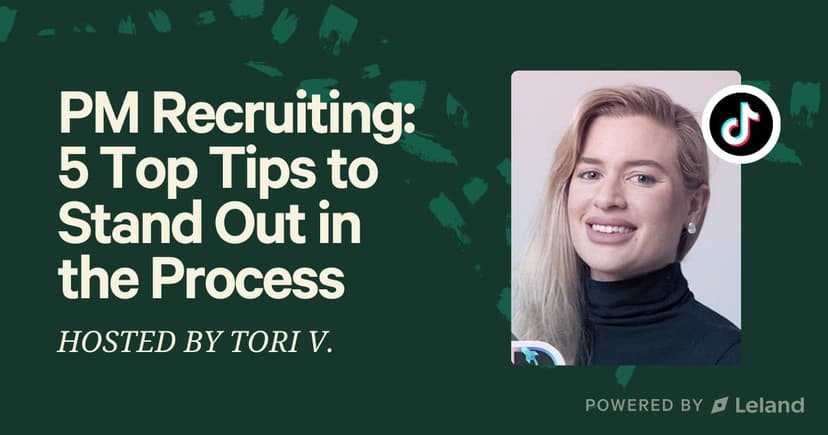Intuit Product Manager: Interview Process, Salary, & Responsibilities
Preparing for a product management interview at Intuit? This guide covers everything you need to know to succeed in the behavioral interview and beyond.
Posted June 13, 2025

Join a free event
Learn from top coaches and industry experts in live, interactive sessions you can join for free.
Table of Contents
Landing a product management role at Intuit is a prestigious achievement. As one of the top tech companies specializing in financial software solutions, Intuit has become an attractive employer for aspiring product managers. However, securing a job at Intuit isn’t easy. The Intuit hiring process is rigorous and designed to identify top talent, so you need to be well-prepared to stand out from the pool of candidates.
In this article, we’ll walk you through everything you need to know to prepare for Intuit product management behavioral interviews and ensure you present yourself as the best fit for the role. Whether you are preparing for a product management or software engineer interview, thorough preparation and practice are essential to excel in the interview process.
What Does an Intuit Product Manager Do?
Before diving into the specifics of the interview process, it’s essential to understand what a product manager at Intuit is expected to do. At its core, the role involves overseeing the entire lifecycle of a product, from ideation through development, launch, and iteration. Product managers at Intuit lead cross-functional teams that include software engineers, designers, marketers, and data scientists to ensure that products meet customer needs and drive business outcomes. Understanding the software engineer interview process is crucial for effective collaboration within these teams.
Key Responsibilities of an Intuit Product Manager
| Responsibility | Description |
|---|---|
| Define Product Strategy and Vision | Product managers collaborate with senior leadership to establish the long-term vision for a product by analyzing market trends, customer pain points, and opportunities. |
| Prioritize Features and Roadmap | They balance trade-offs, prioritize features, and ensure the product delivers maximum value while adhering to budgets and timelines. |
| Collaboration | Product managers work with engineering, design, marketing, and customer support teams to ensure smooth execution and alignment on product goals. |
| Data-Driven Decision Making | Decisions are guided by KPIs, user analytics, and A/B testing, which help validate assumptions and measure success. |
| Stakeholder Management | They engage with stakeholders, incorporating feedback into the product and keeping them updated on progress. |
| Understanding the Software Engineer Interview Process | Familiarity with the engineering interview process ensures effective collaboration, anticipating challenges, and alignment on team goals. |
The Intuit Interview Process: What to Expect

1. Initial Screening with a Recruiter
The Intuit hiring process often begins with a call from a recruiter. During this call, the recruiter will review your resume, ask about your experience, and discuss your motivation for applying to Intuit. They’ll also provide more details about the job, the company, and the responsibilities of the product manager role.
This stage is also a great opportunity for you to ask questions about work-life balance, Intuit’s values, and the company’s culture.
2. Behavioral and Technical Interviews
After the initial screening, you’ll move to the core interview rounds, which will likely include a behavioral interview and a technical interview.
- Behavioral Interview: Expect to answer questions about your past professional achievements, your ability to solve complex problems, and how you’ve managed challenging projects. The Intuit interview questions in this round will be structured around the STAR method (Situation, Task, Action, Result), so be ready to provide detailed examples of how you’ve handled various situations.
- Technical Interview: While product managers are not required to code, you’ll be assessed on your technical skills and understanding of product development. You may be asked technical questions that evaluate your knowledge of software development processes, architecture, and how products are built from start to finish. In a software engineer interview, the focus will be on technical skills and problem-solving abilities.
3. On-Site Interviews or Final Round
The final round of interviews typically involves an on-site interview or a virtual deep dive. Here, you’ll be assessed on your ability to think critically and solve real-world problems that are relevant to Intuit’s products and business challenges. Expect to tackle exercises where you’ll prioritize product features, negotiate with stakeholders, or lead a cross-functional team simulation.
Example Exercises:
- A roadmap prioritization exercise, where you must prioritize features or enhancements based on customer needs, business goals, and technical feasibility.
- A stakeholder negotiation simulation, where you’ll handle conflicting demands from different teams.
4. Leadership Interview
In the final stage, you’ll meet with a manager or senior leadership to discuss your potential fit with Intuit’s values and mission. This interview assesses your leadership style, alignment with the company’s culture, and whether you can thrive in Intuit’s dynamic and fast-paced environment.
Key Skills Intuit Assesses in Product Manager Interviews
1. Leadership and Initiative
Intuit looks for product managers who can lead teams with confidence and clarity. Expect questions about how you’ve demonstrated leadership in previous roles, especially when managing challenging projects or leading teams in a fast-paced environment.
2. Decision-Making
Product managers need to make critical decisions, often under time pressure. Intuit will want to hear about times you’ve had to make tough decisions and how you balanced competing demands. This is particularly important in scenarios involving product roadmaps or when dealing with multiple stakeholders with differing priorities.
3. Collaboration and Cross-Functional Teamwork
Product managers at Intuit work with a variety of teams—engineering, design, marketing, and customer success—to ensure a seamless product experience. Interviewers will be looking for examples of how you’ve worked with diverse teams to achieve a common goal. Understanding the software engineer interview process is crucial for effective collaboration with engineering teams.
4. Adaptability and Problem-Solving
Given that Intuit operates in a dynamic industry, adaptability is a key trait they seek in product managers. You’ll likely be asked questions about your ability to pivot, handle ambiguity, and find solutions to unforeseen challenges.
5. Data-Driven Decision-Making
Product managers at Intuit use data extensively to guide their decisions. Be prepared to discuss how you have used data to inform product direction, validate assumptions, or optimize product features.
The STAR Method
The STAR method breaks down your response into four key components:
- Situation: Set the stage by describing the context of the challenge or scenario you're discussing.
- Task: Explain the specific challenge or responsibility you had in that situation.
- Action: Detail the actions you took to address the challenge or to fulfill your responsibility.
- Result: Highlight the outcome of your actions and any measurable results, as well as what you learned from the experience.
This method not only ensures you provide a well-rounded answer but also helps interviewers quickly understand how you approach problems, make decisions, and lead teams.
Breaking Down Each Element of the STAR Method
1. Situation: Describe the Context
The Situation is the foundation of your story. In this section, you'll need to set the context and explain the environment in which the event took place. You want to give the interviewer enough information to understand what the challenge was and why it was important. Focus on providing relevant details that will highlight the complexity of the task at hand.
What to include:
- Where the situation occurred (e.g., your previous company, a specific project, etc.).
- When it occurred (e.g., during the launch of a product, or while working on a particular initiative).
- Who was involved in the situation (e.g., team members, departments, stakeholders).
2. Task: Define the Problem or Responsibility
Once you've set the scene, the next step is to explain what you need to do. This is where you’ll detail the specific responsibility you were assigned or the problem you needed to solve. Be clear about your role in the situation and the expectations placed on you.
What to include:
- What were your responsibilities? (e.g., managing a product roadmap, delivering a product on time, aligning team priorities).
- What challenges did you face? (e.g., conflicting priorities, resource constraints, tight deadlines).
3. Action: Describe What You Did
The Action step is where you really get to showcase your problem-solving, leadership, and collaboration skills. In this part, you'll explain the steps you took to address the problem or meet your responsibility. This is your chance to highlight your decision-making process, communication skills, and ability to drive results.
What to include:
- What specific actions did you take? (e.g., scheduling meetings, facilitating conversations, negotiating trade-offs).
- How did you collaborate with others? (e.g., how you worked with engineering, marketing, or other cross-functional teams).
- What tools or frameworks did you use? (e.g., prioritization frameworks like MoSCoW, using data to guide decisions).
4. Result: Show the Outcome and What You Learned
The result is the culmination of your efforts. This is where you explain the outcome of the actions you took, ideally with measurable results. It's also important to reflect on what you learned from the experience and how it helped you grow as a product manager.
What to include:
- What was the outcome? (e.g., product launch success, meeting deadlines, improving team efficiency).
- Quantify the impact (e.g., “We launched the product on time,” “The launch exceeded KPIs by 15%,” “Customer satisfaction improved by 20%”).
- What did you learn or take away from the experience? (e.g., insights into prioritization, and the importance of stakeholder management).
Types of Intuit Interview Questions
When preparing for an interview at Intuit, it’s important to be ready for a variety of questions that assess your technical expertise, problem-solving skills, and ability to work effectively in cross-functional teams. Intuit’s interview process is comprehensive and covers a broad range of topics, from coding and technical concepts to behavioral and situational scenarios. Below are the different types of Intuit interview questions you can expect.
1. Intuit Behavioral Interview Questions
- What makes you eligible for this Intuit position?
- How do you prioritize your tasks and manage your time effectively?
- Tell us about a time when you had to navigate conflicting ideas in a team. How did you handle the situation?
- How do you set and achieve professional goals?
- Describe a situation when you encountered a challenge and how you overcame it.
- Tell us about a time when you had to learn a new technology quickly. How did you go about it?
- What steps would you take to resolve a disagreement with a co-worker?
2. Intuit Technical Interview Questions
Intuit Technical Interview Topics:
- Data Structures and AlgorithmsExpect questions that test your ability to solve problems using core data structures and algorithms. Common areas include arrays, strings, trees, graphs, and linked lists.Sample questions:
- Write a program to check if two strings are anagrams of each other.
- How would you reverse a string without disturbing the words?
- Write a program to find the pair of numbers in an array that sum up closest to a given target.
- Object-Oriented Programming (OOP)Product managers at Intuit need to be comfortable with high-level technical concepts, and OOP is frequently tested.Sample questions:
- Explain the principles of object-oriented programming.
- What are the differences between inheritance and composition?
- System DesignAlthough product managers aren’t expected to be engineers, system design questions can still arise, especially if you're expected to understand the product architecture.Sample questions:
- How would you design a scalable URL-shortening service?
- What factors would you consider while designing an API for a cloud-based product?
- Data-Driven Decision MakingProduct managers at Intuit are expected to make data-driven decisions. Expect questions related to data analysis and optimization.Sample questions:
- How would you determine whether a new feature is driving user engagement?
- Describe a time when you used data to make an informed product decision.
3. Intuit Role-Specific Technical Questions
Intuit hires for a range of roles, and depending on the position you're applying for, the technical interview questions may vary.
For Software Engineers:
- How would you handle issues like race conditions and deadlocks in multithreading environments?
- Describe the differences between a linked list and an array. When would you use one over the other?
For Product Managers:
- How do you assess a product's success using data analytics?
- What steps would you take to prioritize features in a product roadmap?
For Front-End Developers:
- What are the key differences between ReactJS and Angular?
- Explain the concept of 'Virtual DOM' in React.
For Back-End Developers:
- Explain the process of designing a scalable microservices architecture.
- What is the role of a database index, and how would you optimize queries?
4. Situational Interview Questions
Situational questions are designed to assess how you would handle specific scenarios in a professional setting. These questions help interviewers gauge your problem-solving, decision-making, and leadership capabilities.
Common situational questions at Intuit might include:
- Describe a time when you had to meet a tight deadline with limited resources. How did you ensure success?
- Tell us about a time when you made a mistake in a product decision. How did you rectify it?
- Imagine you are leading a product team, and one of your key engineers disagrees with the product vision. How would you handle the situation?
These questions test your ability to manage stress, navigate conflicts, and lead teams through challenges effectively.
5. Intuit Domain-Specific Interview Questions
For Senior Software Engineers:
- How would you implement secure SQL queries to avoid injection attacks?
- Explain how to use clustering vs. non-clustering indexes in database management.
For Front-End Developers:
- What are the advantages of using Node.js for back-end development?
- Explain the concept of closure in JavaScript and provide an example.
For Backend Developers:
- How would you build a distributed system to handle a high volume of transactions?
- What are the differences between SQL and NoSQL databases, and when would you choose one over the other?
How to Stand Out in Intuit Interviews

1. Build a Strong Portfolio of Projects
A solid portfolio is key to demonstrating your technical abilities and engineering team collaboration. When preparing for your software engineer interview, include a range of projects that highlight your technical skills. Focus on:
- Diverse tech stacks: Show your ability to work with various technologies, tools, and platforms.
- Real-world impact: Showcase projects that solve relevant problems or provide significant value.
- Clear explanations: Be prepared to explain the projects in a way that demonstrates your understanding of the underlying technology and your ability to solve complex problems.
The interviewer may refer to your portfolio to ask technical questions related to your personal and professional achievements. A well-organized portfolio shows that you are capable of handling multiple tasks in a fast-paced environment and are prepared to take on the responsibilities of the job.
2. Diversify Your Skill Set
Intuit hires software engineers with a broad set of technical skills, and candidates with diversified knowledge tend to stand out. In addition to focusing on specific programming languages like Java, Python, or JavaScript, it’s crucial to have a well-rounded skill set. Some key areas to focus on:
- Data structures and algorithms: Be ready for technical questions on arrays, linked lists, trees, and more.
- System design: Understand the scalable architecture and how to build efficient systems.
- Databases: Be familiar with both SQL and NoSQL databases, including how to optimize queries and design efficient database schemas.
Interviewers expect candidates to have both the experience level and the knowledge to handle real-world problems. Be prepared to explain your thought process and demonstrate your solution approach when answering technical questions.
3. Practice for Situational Questions
Behavioral interview questions are a big part of the Intuit interview process. These questions help interviewers understand how you respond to different situations in the workplace. A key component of your preparation is to practice answering these questions in a way that highlights your analytical skills and cross-functional colleague interaction.
Here are some examples:
- "Tell me about a time when you had to identify a problem within your team and how you handled it."
- "How do you prioritize tasks in a fast-paced environment?"
- "Describe a situation where you successfully worked with a cross-functional team to meet a goal."
4. Align with Intuit Values
Intuit places a strong emphasis on values such as collaboration, innovation, and a commitment to work-life balance. During your interview, show how you align with Intuit values by highlighting examples from your career that demonstrate:
- Teamwork and collaboration: Discuss instances where you successfully worked with other engineers, product managers, and stakeholders to achieve a shared goal.
- Problem-solving in complex environments: Showcase your ability to thrive in fast-paced situations while maintaining a focus on quality and results.
- Commitment to learning and development: Talk about how you continuously learn new technologies, and how you’ve grown through challenges in your previous roles.
Intuit wants to hear how your personal and professional achievements align with the company’s mission, so make sure to communicate these connections clearly in your answers.
5. Demonstrate Critical Thinking and Problem-Solving
During the Intuit interview, you will likely be asked to solve complex problems, so it’s essential to show your ability to think critically and logically. Whether you're answering coding challenges or responding to scenario-based questions, be sure to:
- Break down problems into manageable steps: Show your ability to understand and solve problems methodically.
- Communicate clearly: Explain your thought process and the solutions you’re proposing.
- Handle ambiguity: Demonstrate that you can tackle problems even when not all the data is available, a common situation in software development and product management.
6. Ask Insightful Questions
At the end of your Intuit interview, you will likely have the chance to ask questions. Asking insightful questions not only shows that you are genuinely interested in the position but also helps you assess if the job is the right fit for you. Here are some great questions to ask the interviewer:
- "What does the typical career progression look like for software engineers at Intuit?"
- This shows you are interested in growth and advancement within the company.
- "How do teams at Intuit collaborate across different departments, such as engineering and product management?"
- This highlights your interest in understanding the team dynamics and how you would fit in.
- "What are the biggest challenges currently facing the team, and how can I contribute to overcoming them?"
- This demonstrates your proactive approach and eagerness to contribute immediately.
Intuit Interview Example Answers
Behavioral Questions
Question: Tell us about a time when you had to navigate conflicting ideas in a team. How did you handle the situation?
Answer: In one of my previous roles, I was managing a feature rollout where the engineering team was heavily focused on ensuring technical scalability, while the marketing team was pressing for a quick launch to align with a campaign. Both sides had valid points, but their goals conflicted. To address this, I brought everyone together for an open discussion where each team could share their concerns. Using a prioritization matrix, we evaluated the impact and effort required for different approaches. I proposed a phased rollout, where we’d launch a basic version to meet the marketing timeline and follow up with enhancements to address the scalability concerns. Everyone agreed, and the phased approach allowed us to meet the campaign deadline while improving the product incrementally. The outcome was a successful launch with a 25% boost in customer satisfaction post-enhancements.
Question: Describe a situation where you successfully worked with a cross-functional team to meet a goal.
Answer: During a platform migration project, I worked closely with engineering, design, and customer success teams to ensure the transition was seamless for users. My role was to create a clear roadmap, anticipate risks, and keep everyone aligned throughout the process.
To keep things on track, I set up weekly sync meetings and created a shared dashboard for progress updates. When a significant blocker emerged regarding data migration, I facilitated a brainstorming session that led to an alternative solution. By staying proactive and ensuring continuous communication, we completed the migration two weeks ahead of schedule. Not only that, but customer support tickets decreased by 30% in the first month, and we maintained a 95% user retention rate.
Technical Questions
Question: How would you prioritize features in a product roadmap?
Answer: When prioritizing features, I focus on three main factors: customer value, business impact, and the effort required. For example, in a previous role, we were deciding whether to add a “bulk edit” feature to an e-commerce tool. I used customer feedback and analytics to determine it was one of the top-requested features and aligned it with business goals to improve retention. By using a RICE framework—looking at the Reach, Impact, Confidence, and Effort—I showed the team that the feature required minimal engineering work but could significantly boost retention. After implementing the feature, we saw a 15% increase in retention within the first quarter.
Question: How would you design a scalable API for a cloud-based product?
Answer: Designing a scalable API involves focusing on both usability and performance. For instance, I worked on a project where we needed an API to handle a high volume of user requests efficiently. I collaborated with engineers to design a RESTful API that adhered to industry best practices. We incorporated caching to reduce latency, rate limiting to ensure stability, and robust authentication using OAuth to maintain security. One of the key challenges was balancing speed and scalability, especially during peak usage times. By adding logging and monitoring tools, we were able to proactively address potential bottlenecks. The result was an API that supported over a million daily requests, with latency reduced by 40% and no downtime during critical periods.
Situational Questions
Question: Imagine you are leading a product team, and one of your key engineers disagrees with the product vision. How would you handle the situation?
Answer:I once worked on a new AI-powered feature where a senior engineer felt the vision wasn’t technically feasible. Instead of dismissing their concerns, I scheduled a one-on-one to fully understand their perspective. It became clear that some assumptions about the technical requirements needed to be revisited. I facilitated a team session to brainstorm solutions and brought in a data scientist to validate some of the key technical challenges. Ultimately, we adjusted the scope of the feature to align with what was technically achievable while still meeting the product vision. Not only did this process build trust with the engineer, but the resulting feature was a success and drove a 20% increase in user engagement after launch.
Question: Describe a time when you had to make a data-driven decision to solve a problem.
Answer: In one instance, we noticed a 15% drop in user retention after releasing a new feature. I immediately analyzed user behavior data and conducted surveys to identify the root cause. The data revealed that the feature added unnecessary complexity, which frustrated users. I led a redesign to simplify the workflow and ran A/B tests to ensure the new version addressed the issues. After implementing the updates, retention improved by 20% within three months, and our Net Promoter Score increased by 10 points. This experience reinforced the importance of using data not just to identify problems but also to guide and validate solutions.
Key Takeaways
- Understand the role of a product manager at Intuit and what it involves
- Practice behavioral interview questions using the STAR method to share your experiences
- Be ready to discuss technical knowledge and your ability to collaborate with engineers
- Show how you adapt to challenges and make decisions under pressure
- Highlight how your values align with Intuit’s mission and culture
Work with Product Management Coaches
Get expert guidance to refine your interview strategy, strengthen your responses, and boost your confidence. With tailored coaching, you'll learn how to effectively showcase your leadership, decision-making, and problem-solving skills, and be fully prepared to tackle every stage of the interview process.
FAQs
What does a Product Manager do at Intuit?
- A Product Manager at Intuit oversees the product lifecycle from ideation to launch and iteration. They work with cross-functional teams, including software engineers, designers, marketers, and data scientists, to ensure that products meet customer needs and business goals. Key responsibilities include defining product strategy, prioritizing features, collaborating with teams, making data-driven decisions, and managing stakeholders.
How can I prepare for behavioral interview questions at Intuit?
- To prepare for behavioral interview questions, use the STAR method (Situation, Task, Action, Result). This method helps structure your answers by providing context, defining your responsibilities, detailing your actions, and highlighting measurable results. Practice answering questions about leadership, decision-making, adaptability, collaboration, and data-driven problem-solving.
What technical knowledge is required for a Product Manager at Intuit?
- While Product Managers at Intuit don’t code, they need a strong understanding of technical concepts. This includes knowledge of software development processes, architecture, and data-driven decision-making. Familiarity with system design, APIs, and analytics tools is also beneficial for effective collaboration with engineering teams.
What qualities does Intuit look for in a Product Manager?
- Intuit seeks candidates with strong leadership, decision-making, and adaptability skills. They value collaboration across teams, the ability to work in a fast-paced environment, and a commitment to innovation. Product Managers should also demonstrate proficiency in data-driven decision-making, stakeholder management, and aligning with Intuit’s mission and values.
Related Articles
- The Different Types of Buy-Side Firms–and How to Choose One
- Top 3 Tactics to Ace Your Case Interview
- An Expert’s Guide to Resumes: Five Tips to Make You Stand Out
- How to Write a Winning Consulting Cover Letter
- 20+ Best Questions to Ask at the End of an Interview
- 20+ Second-Round Interview Questions You Need to Know
Browse hundreds of expert coaches
Leland coaches have helped thousands of people achieve their goals. A dedicated mentor can make all the difference.



























